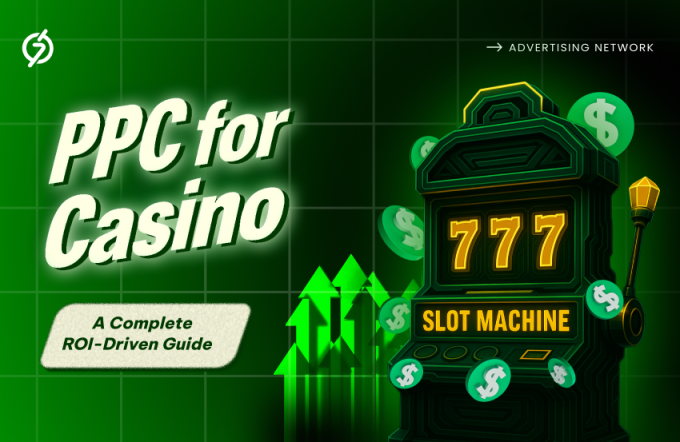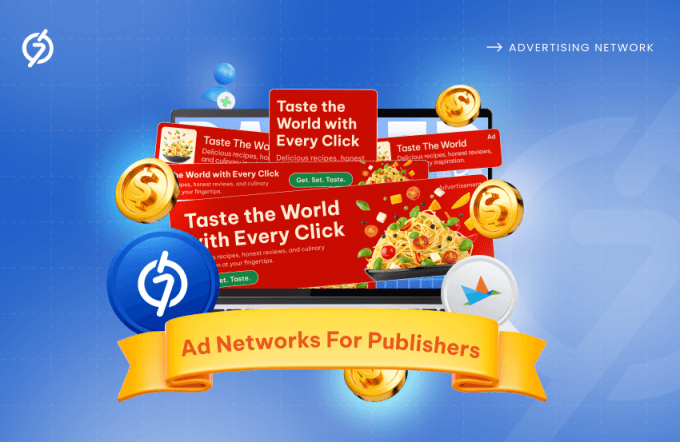Confused between ad exchange vs ad network for your advertising and publishing goals?
Each has its own benefits and limitations for businesses, and thus, it’s crucial to understand the differences between ad exchange and ad network for maximum ad revenue. This ad exchange vs ad network comparison guide will help you choose the best ad solution. This guide will walk you through:
- What is an ad exchange?
- What is an ad network?
- What is the difference between an ad network and an ad exchange? (Ad Exchange Vs Ad Network)
- How do both ad monetization models work?
- Ad exchange and ad network examples.
Let’s explore this research-backed, beginner-friendly comparison guide of ad exchanges vs. ad networks.
What is an Ad Exchange?
An ad exchange is a digital marketplace that connects advertisers (via DSP) and publishers (via SSP) to buy and sell ad inventory in real-time using automated systems.
To monetize websites and apps, publishers connect to ad servers and SSPs (supply-side platforms). These SSPs then connect publishers to multiple ad exchanges and ad networks, where advertisers perform real-time bidding (RTB) for available ad spaces.
The advertiser who places the highest bid in real-time wins the ad space, and their ad starts to appear on the publisher’s website or app. For this, they utilize a DSP (demand-side platform) that enables them to conduct real-time auctions and purchase digital ad inventories. This is also known as programmatic ad buying.
Types of Ad Exchanges for Publishers and Advertisers
Based on access and ease of use, ad exchanges are divided into the following categories.
1. Open Ad Exchange
An open advertising exchange model enables anyone to buy and sell ad inventory without restrictions.
It’s like a big market where advertisers and publishers buy and sell digital ad spaces to maximize reach and monetize their websites.
Although advertisers can maximize reach, publishers face issues such as lower-quality ads placed on websites that interrupt the on-site users’ experience.
2. Private Ad Exchange
A private ad exchange is like a private marketplace where publishers can choose who can advertise and place only premium-quality ads to maintain their brand safety.
For instance, a blogging website providing educational content on WordPress and WooCommerce can allow ads from reputable and trustworthy hosting and domain providers. This maintains integrity and credibility among their readers.
Also Read: How to Make Money by Posting Ads
3. Hybrid Ad Exchange
Hybrid ad exchanges are a combination of open and private models. In this model, publishers can sell some of their ad spaces through open ad exchanges while reserving premium slots for private advertising exchanges, thereby maintaining brand integrity and increasing ad revenue.
For instance, a lifestyle blogging website can sell some of its ad spaces via an open ad exchange and keep the premium slots for big brands like Calvin Klein, Gucci, Nike, and others.
Also Read: The Impact of Ad Exchange in Digital Advertising
Ad Exchange Working
![Ad Exchange Vs Ad Network: What’s The Difference? [A Complete Guide] 2 Ad Exchange Working](https://www.7searchppc.com/blog/wp-content/uploads/2024/03/Ad-Exchange-Working.png)
In the ad exchange vs ad network comparison guide, let’s use an ad exchange example to better understand how ad exchanges work.
An ad exchange connects advertisers (via DSP) and publishers (via SSP) to buy and sell ad inventory using the RTB mechanism. The moment a user lands on the publisher’s website, a real-time auction triggers through an SSP tool. Now, several advertisers that are connected to a DSP tool participate in the auction to win the available ad slots. The advertiser who places the highest bid wins the ad placement, and their ad starts to appear on the publisher’s website within seconds.
The ad exchange model utilizes platforms, automation, and RTB to work effectively. It helps advertisers secure premium slots, increasing viewability and awareness by targeting a specific audience, whereas publishers earn the opportunity to receive the highest bid for their inventories.
Also Read: DSP Advertising: Key Components You Need to Know
Advantages of Ad Exchanges
Advertising exchanges offer compelling benefits for both advertisers and publishers. The table below explains all the features of the ad exchange for advertisers and publishers.
| Key Feature | Ad Exchange Benefits for Advertisers | Ad Exchange Benefits for Publishers |
|---|---|---|
| Full transparency over ad inventory. | Advertisers know whose ad inventory they are buying. | Publishers know who is placing the ads. |
| Automates process and real-time bidding. | Advertisers can participate in real-time auctions to secure ad space on websites and apps. | Publishers don’t have to negotiate and connect personally. |
| Flexibility and control are achieved through filters and rules. | Advertisers target ads based on various factors, including audience, location, device, and demographics. | Publishers can set floor prices, block certain categories and advertisers, decide ad placement, restrict ad formats, and even run private deals. |
| Yields better results. | Advertisers can show digital ads on websites that align with their audience’s interests and behavior, helping them pay for impressions that are genuinely valuable. | Publishers have the opportunity to receive the highest value for their ad spaces. |
Advertising exchanges enable publishers to get higher bid values and have more transparency and control over their ad spaces. Whereas advertisers have the opportunity to better target their ads. Although it offers superb functionalities, it has several flaws that can’t be ignored.
Limitations of Ad Exchanges
Ad exchanges have several limitations, and it’s imperative to know them to select the ideal ad solution that matches your needs. Therefore, to help you get started and pick the right ad solution, we’ve cited the ad exchange limitations.
- Setting up ad servers, SSPs, and DSPs can be a complex process that requires technical expertise.
- Bottleneck competition as popular and reputable websites attract advertisers, and their ad space is sold faster at higher rates compared to small businesses.
- Publishers can block certain categories and advertisers, but they still can’t choose the ads they don’t want to show on their website to reduce ad fraud cases.
- Data privacy and bot traffic, which can lead to fake impressions, are issues beyond advertisers’ control.
- SSPs and DSPs platforms take a cut from each transaction.
- Advertisers pay more for premium slots.
- Some of the ad exchanges in the market don’t disclose their actual pricing.
In the ad exchange vs. ad network comparison, the above limitations make advertising exchanges more expensive, and issues such as data privacy and bot traffic make them less efficient.
Read: How Does Ad Fraud Work and How Can You Protect Your Ads?
What is an Ad Network?
An ad network is a platform that works as an intermediary between advertisers and publishers. It’s a popular ad monetization method, as it enables advertisers to create ad campaigns and publishers to monetize their websites without requiring personal interaction.
How do Ad Networks Work?
![Ad Exchange Vs Ad Network: What’s The Difference? [A Complete Guide] 3 Ad Network Working](https://www.7searchppc.com/blog/wp-content/uploads/2024/03/Ad-Network-Working.png)
Ad networks aggregate ad spaces from publishers, and advertisers add a certain amount to their wallet to purchase ad spaces based on clicks, impressions, and actions. (Advertisers needed to add at least the minimum threshold amount specified by the ad network to buy ad spaces.) Therefore, it’s a good idea to check the minimum amount before using an ad platform.
But how do they actually work? We’ve provided an ad network example to help you better understand its functionalities.
1. Collects Ad Inventory From Publishers
Publishers register on ad networks like 7SearchPPC to sell their ad spaces and monetize website traffic.
2. Advertisers Create Campaigns via Advertiser Dashboard
Advertisers partner with ad networks to create targeted ad campaigns that promote their offerings and build brand awareness within a set budget. Advertisers can choose to pay for their ads based on clicks, impressions, or actions.
Also Read: Maximizing Ad Targeting: The Power of Web Traffic
3. Match and Place Ad Inventory Based on Set Criteria
The digital ad platform utilizes algorithms to match and deliver ads based on selected categories, ad format, and target audience.
Suppose you’ve a healthcare website and decide to sell ad inventory using the 7SearchPPC self-serve ad network.
The platform uses algorithms to search for ads that match your selected ad categories and format, and then provides ad codes for you to place on your website.
4. Monitor and Track Ad Performance
Ad networks facilitate advertisers and publishers to track, monitor, and optimize their ad campaigns and ad revenue. This enables advertisers to enhance their ad performance and publishers to earn more money via ads.
Ad networks are less expensive and give you the opportunity to create ad campaigns within a budget. They also provide equal opportunities for both small and large-scale publishers to generate passive income from the website traffic.
Read More: 16 Best Ad Networks for Publishers
Why Choose Ad Networks: Are They Superior to Ad Exchanges?
We’ve prepared a table outlining the benefits of ad networks to help you better understand the difference between ad exchanges and ad networks.
| Key Feature | Ad Network Benefits for Advertisers | Ad Network Benefits for Publishers |
|---|---|---|
| Ease of Use | Advertisers can easily create targeted ad campaigns and place bid prices. | The publisher ad network generates clean and safe ad codes that are easy to embed on websites. |
| Pricing Models | CPC, CPM, and CPA are the most common pricing models offered by most digital ad networks. | Publishers can choose from different pricing models and select the one that best suits their website’s goals and needs. |
| Engaging Ad Formats | Ad networks offer a diverse range of ad formats, providing multiple ways to capture users’ attention. | Publishers can decide the ad unit that resonates more with their target audience. |
| No Hidden Fees | There are no setup or hidden charges involved. | Publisher registration is mostly free, and there are no hidden charges involved. |
| Expert Ad Managers Support | Most digital ad networks, including 7SearchPPC, provide advertisers with support from ad managers to create targeted ad campaigns and optimize ad performance. | Support from the customer helpdesk is available 24/7. |
| Primary Functionalities | Create targeted ad campaigns based on country, device, and OS. | Select your ad type, placement, pricing model, and multiple payout options. |
| Broad Reach | Advertisers can reach a wider audience to spread awareness about the offerings and build brand credibility. | Publishers can sell ad spaces to multiple advertisers without needing to connect and pitch on a personal level. |
| Bot Traffic and Disturbing Ads Prevention | Advertisers can receive bot-free traffic, avoiding fake impressions and clicks, and pay only for genuine traffic. | Some ad networks also allow publishers to choose to accept or ignore erotic ads to maintain on-site user engagement. |
| No Chaos and Timely Payouts | No manual negotiation for ad slot and pricing that removes the chaos and allows advertisers to focus on ad performance. | Publisher ad network also allows them to withdraw bi-monthly or weekly payouts. |
| Digital Ad Network Setup | Setting up an ad platform doesn’t require technical expertise. | Technical skills are not required to place ad codes. |
In the ad exchange vs ad network comparison, ad networks offer unique benefits that set them apart for both advertisers and publishers.
How to Select the Right Ad Network?
What are ad networks? How do digital ad networks work? Now that we know this, the question arises: how do we select the best ad network?
To help you get started and select the best ad platform, we’ve prepared a list. Go through the points and consider them before selecting your ad network.
Identify Your Objectives
The first crucial step is to identify your objectives. If you are an advertiser, find out how and where you want to display your ads. What’s the main purpose of creating ads, and how are you going to check the effectiveness of ads?
If you are a publisher, find out where and which ads you want to place, and how you can maximize ad profit. Learn different effective tips and tricks to generate more passive income via ads.
Check Digital Ad Network Reputation
Before creating campaigns or monetizing a website, check the ad network’s reputation in the market. For this, go through the reviews and case studies to ensure that working with the ad platform won’t affect your business or website.
Read: How to Choose the Right Advertising Platform for Your Business
Ask for Multiple Ad Formats
User engagement and conversion depend on the ad format you choose to create ad campaigns and monetize your website. Not every user responds in the same manner. Therefore, it’s imperative to understand audience behavior and preferences while selecting the ad format.
For a food blogging website, native and banner ads can capture more user attention than pop-ups and interstitial ads.
You can consider the 7SearchPPC ad network, as it supports a diverse range of ad formats, including native, banner, text, in-page push, and pop-under, for effective ad monetization.
Also Read: Effective Ad Formats for Increasing Website Revenue
Check Pricing Models and Payout Terms
When it comes to network charges, as an advertiser, it’s essential to consider your budget and campaign goals. Many digital ad networks offer CPC, CPM, and CPA pricing models.
Read: CPC vs CPM: What’s the difference?
Decide how you want to pay for the ad spaces, and then select the ad platform that offers the pricing model you prefer.
As a publisher, you must research the payout terms to ensure they align with your revenue objectives. So, you can easily reach the minimum payout threshold for your ad spaces and maintain a consistent stream of income.
Provide Basic to Advanced Functionalities
The ad platform should offer a range of functionalities, from basic to advanced. It can include simple ad creation, fast website verification, and real-time tracking and monitoring with multiple filters to improve ad performance.
Check Support and Ease of Use
Your selected ad platform should offer 24/7 customer support to help you with your queries and optimize your ad performance.
Along with this, using the platform should be a smooth process for all. The dashboard should have a clean and simple interface, and it should not feel like you’re coding to set up the entire ad network.
Also Read: Top 12 Highest Paying Ad Networks in 2025
Check Support for Advertising Verticals
Not all ad networks provide support to all lines of business and sizes. For instance, Google AdSense doesn’t accept the gambling vertical. Therefore, before registering on a digital ad network, consider whether it offers the vertical support your business needs.
Finding a suitable platform can be challenging; therefore, we recommend 7SearchPPC, as it supports all types of businesses and website niches. Whether it’s dating, gaming, healthcare, or gambling, we want to support and help users across all advertising verticals.
As an advertiser, you don’t need to hurry to start your ad campaign with a high budget. You must start with a minimum budget and check that you are getting the desired outcomes from the chosen display advertising network.
If you are not satisfied with the results, you can consider other alternatives. The same applies to publishers; you can allocate your ad space and monitor the earnings and payouts to determine whether the chosen display advertising network is delivering satisfactory results.
Ad Exchange vs Ad Network: Key Differences Explained
It’s time to discover the key difference between an ad network and an ad exchange. Take a look at the comparison table to know what’s better for display advertising.
Ad Exchange vs Ad Network: Comparison Table
| Parameter | Ad Exchange | Ad Network |
|---|---|---|
| How does it work? | When a user visits a publisher’s site, impressions enter real-time bidding; the highest bidding advertiser wins and secures ad space. | Act as intermediaries, facilitating the exchange of ad slots between advertisers and publishers. |
| What ad inventory is available? | Access to a vast and real-time digital ad inventory, including premium ad slots. | Aggregated digital ad spaces from publishers enable advertisers to reach a diverse range of website niches. |
| How much control does it offer? | Advertisers target audiences by age, interest, location, and cookies; publishers set floor prices, block ads, and run premium deals. | Both can choose categories, ad units, and target ads by device, platform, and country for optimization. |
| What’s the pricing? | The pricing depends on the demand and competition for ad spaces. | Advertisers and publishers choose CPC, CPM, or CPA pricing models. |
| How much transparency does it offer? | Advertisers and publishers both know who is placing the ad and where it is being placed. | Ad networks may disclose or hide ad placements and advertiser identities. |
| What targeting options does it have? | Provides contextual, demographic, and behavioral ad targeting. | Provides contextual, device, platform, and GEO advertising targeting. |
| Who can use the ad monetization model? | Ideal for advertisers and agencies who’re seeking to acquire premium ad slots on high-traffic websites. | Best for small publishers; advertisers seek bulk impressions within budget. |
| Whom to connect? | Need SSP, DSP, and ad hosting to connect with ad exchanges. | Register with a reputable and trustworthy digital ad network. |
Read: Ad Monetization Strategies Every Publisher Should Know
Ad Exchange vs Ad Network: What’s Better
So, these were the key differences between ad networks and ad exchanges. After conducting in-depth research, we can conclude that ad networks are a far better option compared to ad exchanges in the ad exchange vs. ad network comparison guide. As ad networks don’t have hidden fees, they don’t require technical know-how and are more feasible for small-scale advertisers and publishers.
However, if you’ve a large-scale business or website and can afford the platform fees, you can utilize advertising exchanges. Evaluate your goals, audiences, size, and budget, and then select an ad monetization model. If needed, you can use both ad monetization models.
Frequently Asked Questions
What role does an ad network play in online advertising?
Ans. Ad networks play a crucial role in online advertising. They connect advertisers with publishers to display ads on websites and blogs. It helps advertisers showcase their products and services to a targeted audience, while also enabling publishers to monetize their online content and generate ad revenue.
What are the advantages of using a digital ad network?
Ans. There are various benefits of using an ad network, such as global reach, precise targeting options, cost-effective display advertising solutions, engaging ad formats, and a simple setup process.
What are the benefits of a publisher ad network?
Ans. Ad networks provide publishers with the opportunity to generate revenue by displaying ads on their websites and blogs. Connect with 7SearchPPC to effortlessly monetize website traffic.
Is ad monetization possible along with other website monetization methods?
Ans. Yes, it’s possible to combine other monetization methods, such as affiliate marketing, sponsored content, donations, and memberships, with the ad monetization model.
In ad exchanges vs ad networks: who provides more control over ad spaces?
Ans. In ad exchanges vs ad networks, ad exchanges provide more control over ad inventory to publishers.
Ad exchange vs ad network: which ad monetization model should you choose?
Ans. Both ad exchanges and ad networks have their own benefits and limitations. For instance, ad networks work better for small website owners and publishers with a limited budget. Whereas advertising exchanges are a better option for owners with a high budget. Look at your goals, budget, and audience to choose the best ad monetization model.

![Ad Exchange Vs Ad Network: What’s The Difference? [A Complete Guide] 1 Ad Exchange Vs Ad Network](https://www.7searchppc.com/blog/wp-content/uploads/2024/03/Ad-Exchange-VS-Ad-Network.png)















